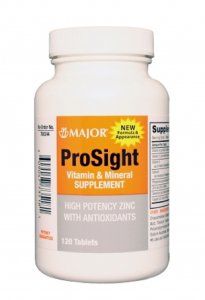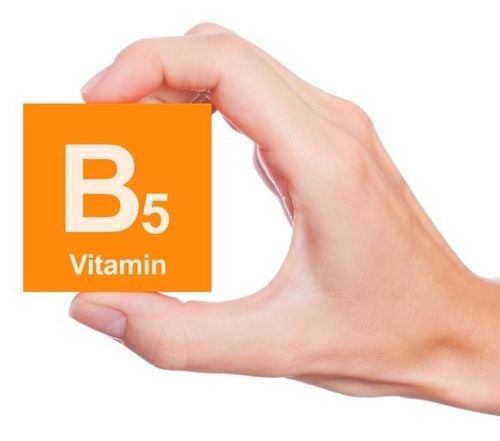This is an automatically translated article.
Micronutrients in food are one of the main groups of nutrients needed by the body. These include vitamins and minerals, which play an essential role in energy production, supporting immune function, blood clotting, growth, bone health, fluid balance, and several other processes.
1. What are micronutrients?
The term micronutrients is used to describe vitamins, minerals in general and macronutrients in particular, including proteins, fats, carbohydrates.
The body needs micronutrients less than macronutrients. Therefore, it is also labeled as trace. Most vitamins and minerals are not produced in the body and must be obtained from food. That is why they are also known as essential nutrients.
Vitamins are organic compounds made from plants and animals that can be broken down by heat, acids or air. In contrast, minerals are inorganic substances, which exist in soil or water and cannot be broken down. When eaten, the body consumes the vitamins that plants and animals make or the minerals they absorb.
The micronutrient content in each food is not the same, so it is best to eat a variety of foods to get enough vitamins and minerals. Adequate intake of all micronutrients is essential for optimal health, as each vitamin and mineral has a specific role in the body. Vitamins and minerals are important for growth, immune function, brain development and many other important functions. Depending on their function, some micronutrients also have a role in preventing and fighting disease.
2. Micronutrients and their functions

Vitamin B6 giúp cơ thể giải phóng đường từ carbohydrate
Vitamins and minerals can be divided into four categories: Water-soluble vitamins, fat-soluble vitamins, trace elements and trace minerals. All vitamins and minerals are absorbed in similar ways in the body and interact in many processes.
2.1 Water-soluble vitamins Most vitamins are water-soluble. They are not easily stored in the body and will be excreted in the urine when consumed in excess. Each water-soluble vitamin has a unique role in performing their function. For example, most B vitamins act as enzymes that help trigger important chemical reactions. Many of these reactions are necessary for energy production.
Water-soluble vitamins include:
Vitamin B1 (thiamine): Helps convert nutrients into energy. Vitamin B2 (riboflavin): Necessary for energy production, cell function, and fat metabolism. Vitamin B3 (niacin): Promotes the production of energy from food. Vitamin B5 (pantothenic acid): Necessary for fatty acid synthesis. Vitamin B6 (pyridoxine): Helps the body release sugar from stored carbohydrates for energy and to make red blood cells. Vitamin B7 (biotin): Plays a role in the metabolism of fatty acids, amino acids, and glucose. Vitamin B9 (folate): Important for proper cell division. Vitamin B12 (cobalamin): Necessary for red blood cell formation and proper nervous system and brain function. Vitamin C (ascorbic acid): Creates neurotransmitters, collagen, and proteins Water-soluble vitamins play an important role in energy production but also have several other functions. Since these vitamins are not stored in the body, it is important to get enough of them from food. Sources and recommended amounts of water-soluble vitamins are listed in the following table:
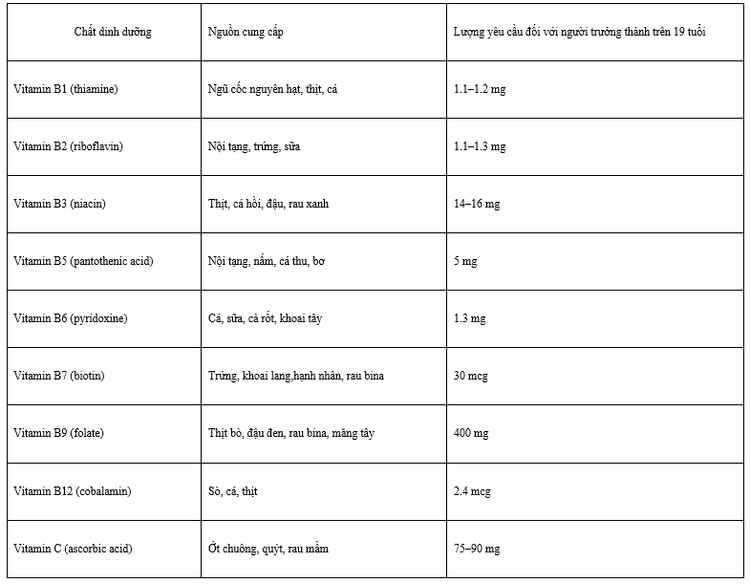
2.2 Fat-soluble vitamins Fat-soluble vitamins are insoluble in water. They absorb best when consumed with fat. Once consumed, fat-soluble vitamins are stored in the liver and fatty tissues for gradual use. Fat-soluble vitamins include:
Vitamin A : Essential for vision and proper organ function Vitamin D: Promotes immune function, aids calcium absorption and bone development Vitamin E : Supports normal function immune function and acts as an antioxidant to help protect cells from damage. Vitamin K: Necessary for blood clotting and bone development. Sources and recommended amounts of fat-soluble vitamins are listed in the following table:
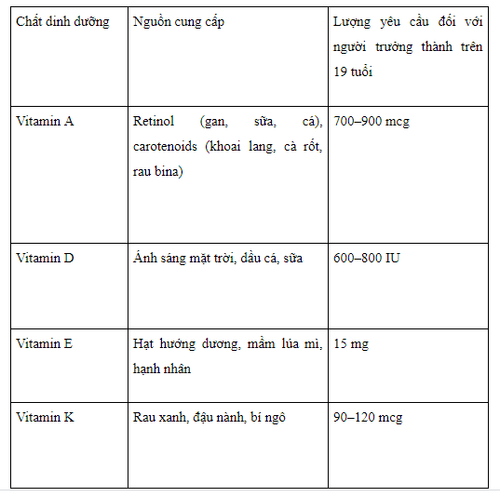
2.3 Trace Elements of bones and teeth. Supports muscle function and blood vessel constriction. Phosphorus: Part of the periosteal and cellular structure. Magnesium: Supports more than 300 enzymatic reactions, including blood pressure regulation. Sodium: An electrolyte that helps balance fluids and maintain blood pressure. Chloride: Usually found in combination with sodium. Helps maintain fluid balance and is used to aid digestion. Potassium: An electrolyte that maintains a fluid state in cells and helps with nerve transmission and muscle function. Sulfur: Part of every living tissue and present in the amino acids methionine and cysteine The sources and recommended amounts of trace elements are listed in the following table:
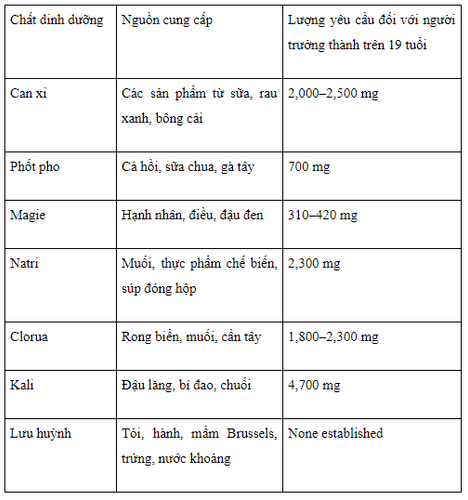
2.4 Trace Minerals Trace minerals are needed in smaller amounts than trace elements but are still sufficient to support important functions in the body. Trace minerals and some of their functions are:
Iron: Provides oxygen and aids in the creation of certain hormones Manganese: Supports carbohydrate, amino acid and cholesterol metabolism Copper: Necessary for the formation of connective tissue , as well as normal brain and nervous system function. Zinc: Necessary for normal growth, immune function and wound healing. Iodine: Supports thyroid regulation. Fluoride: Necessary for the development of bones and teeth. Selenium: Important for thyroid health, reproduction and protection against oxidative damage. Sources and recommended amounts of trace minerals are listed in the following table
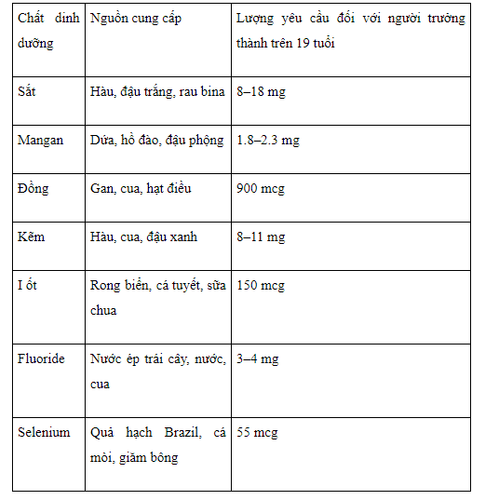
3. Health Benefits of Micronutrients
All micronutrients are important for the body to function. Consuming adequate amounts of various vitamins and minerals is key to optimal health and may even help fight disease. Because micronutrients are involved in almost every process in the body. What's more, certain vitamins and minerals may act as antioxidants to protect against cell damage that is linked to a number of diseases, including cancer, Alzheimer's, and heart disease.
Research has linked adequate dietary intake of vitamins A and C to a reduced risk of certain types of cancer. Getting enough of certain vitamins may also help prevent Alzheimer's disease. A review of seven studies found that getting enough vitamins E, C and A in the diet was associated with a 24%, 17%, and 12% reduction in the risk of developing Alzheimer's disease.
Certain minerals also play a role in preventing and fighting disease. Research has linked low blood selenium levels with a higher risk of heart disease. A review of observational studies found that the risk of heart disease decreased by 24% when blood selenium levels increased by 50%. Additionally, a review of 22 studies found that adequate calcium intake reduced the risk of death from heart disease and all other causes. These studies suggest that adequate consumption of all micronutrients, especially those with antioxidant properties, provides ample health benefits.
4. Micronutrient deficiencies and toxicity
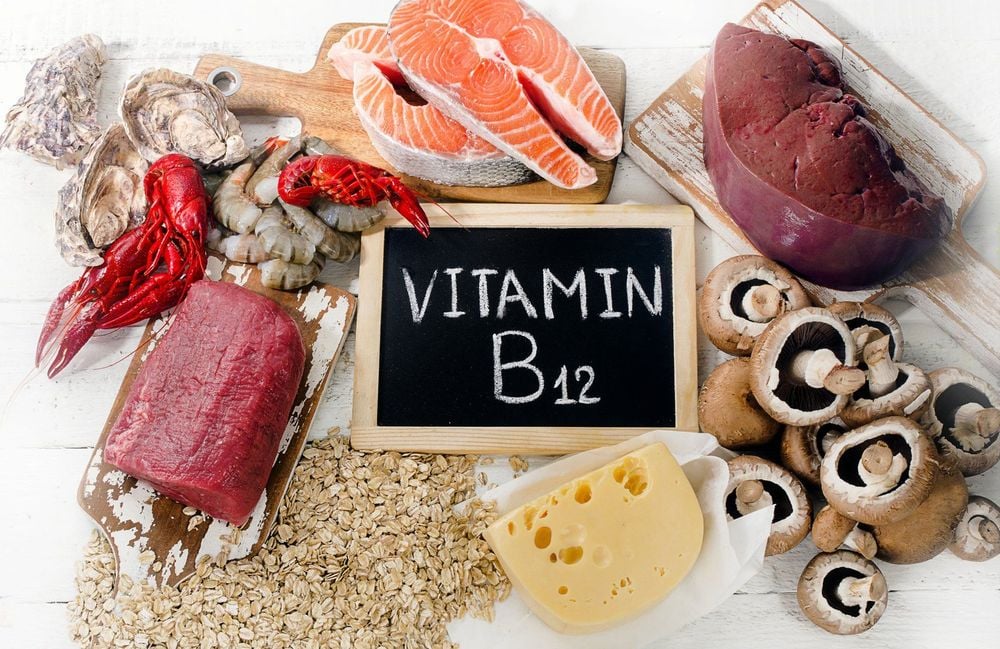
Người ăn chay thường thiếu vitamin B12
Micronutrients are needed in specific amounts to perform their functions in the body. Getting too much or too little of a vitamin or mineral can lead to negative side effects.
4.1 Deficiency Most of the time, a healthy adult body can get adequate amounts of micronutrients from a well-balanced diet. Some of the nutrients that are commonly deficient include:
Vitamin D: About 77% of Americans are vitamin D deficient, mainly due to a lack of sunlight Vitamin B12: Vegetarians may be deficient in vitamin B12 due to non-alkaline manufacture animal products. The elderly are also at risk of vitamin B12 deficiency due to age-related decline in absorption of Vitamin A: The diets of women and children in the developing world are often deficient in vitamin A. Iron: A deficiency of this mineral is common in preschool children, menstruating women, and vegetarians. Calcium: Nearly 22% and 10% of men and women over the age of 50, respectively, do not get enough calcium. The signs, symptoms, and long-term effects of these deficiencies depend on the individual nutrient but can be detrimental to body functioning and optimal health.
4.2 Toxicity Trace toxicity is less common than deficiency. They are more likely to occur when given large doses of the fat-soluble vitamins A, D, E and K because these nutrients can be stored in the liver and fatty tissues. They cannot be excreted from the body like water-soluble vitamins. Micronutrient toxicity usually develops from excess intake, rarely from dietary sources.
Toxicity signs and symptoms vary depending on the nutrient. It's important to note that consuming too much of certain nutrients can still be dangerous even if it doesn't lead to symptoms of excessive toxicity. One study examined more than 18,000 people at high risk of lung cancer from smoking or past asbestos exposure. The intervention group was given two types of vitamin A - 30 mg of beta-carotene and 25,000 IU of retinyl palmitate per day. The trial had to be stopped ahead of time when the intervention group showed 28% more lung cancer cases and a 17% higher 11-year mortality rate than the control group.
The safest and most effective way to get adequate amounts of vitamins and minerals is from food sources. If interested in taking a micronutrient supplement, look for trusted products or have it as directed by your healthcare provider, and avoid products that contain high doses of micronutrients.
The term micronutrients refers to vitamins and minerals, which can be divided into trace elements, trace minerals and water and fat soluble vitamins. Vitamins are needed for energy production, immune function, blood clotting and other functions while minerals are beneficial for growth, bone health, fluid balance and other processes. To get an adequate amount of micronutrients, aim for a balanced diet that contains a variety of foods.
Vinmec International General Hospital with a system of modern facilities, medical equipment and a team of experts and doctors with many years of experience in medical examination and treatment, patients can rest assured to visit. examination and treatment at the Hospital.
Please dial HOTLINE for more information or register for an appointment HERE. Download MyVinmec app to make appointments faster and to manage your bookings easily.
Reference source: healthline.com
MORE
Role of vitamins and minerals in the body 4 important groups of nutrients: Carbohydrates, fats, proteins, vitamins and minerals The best time to take vitamins





